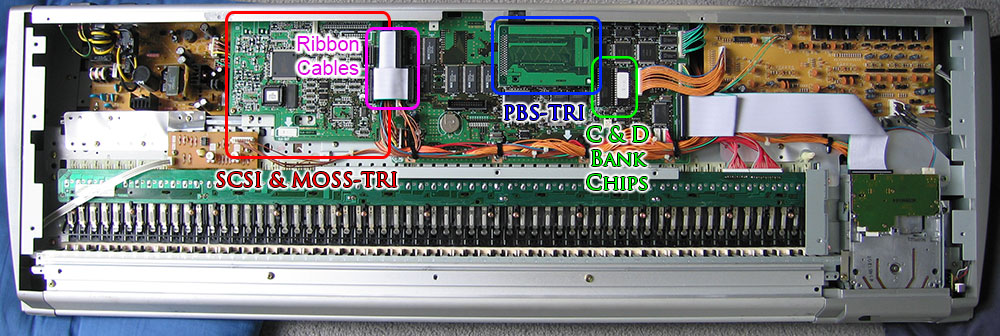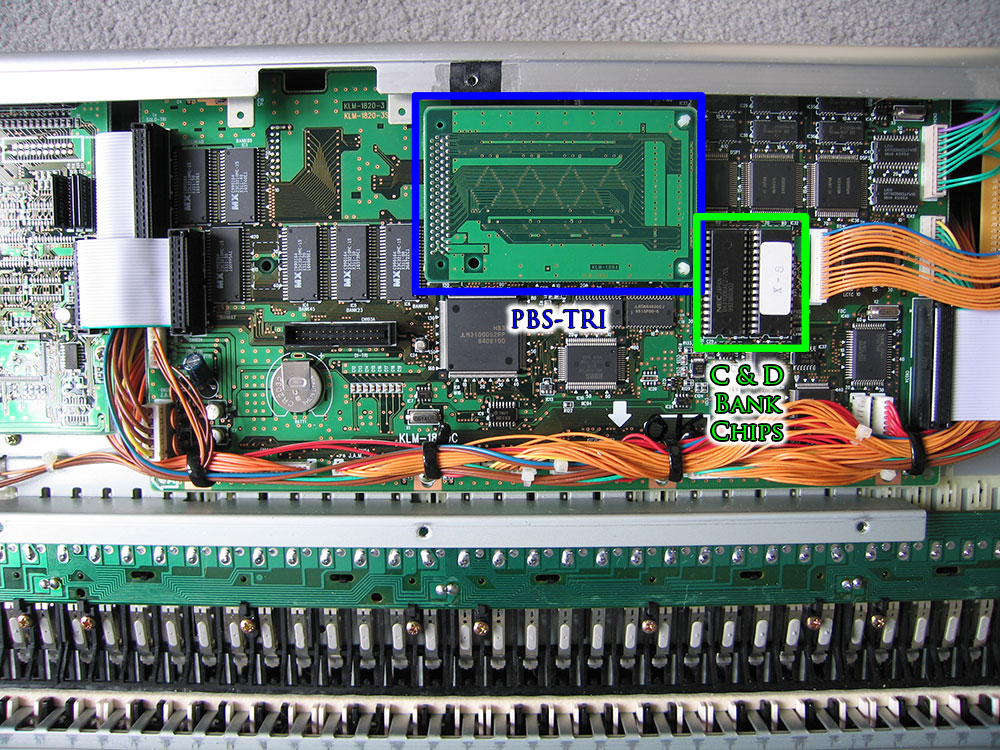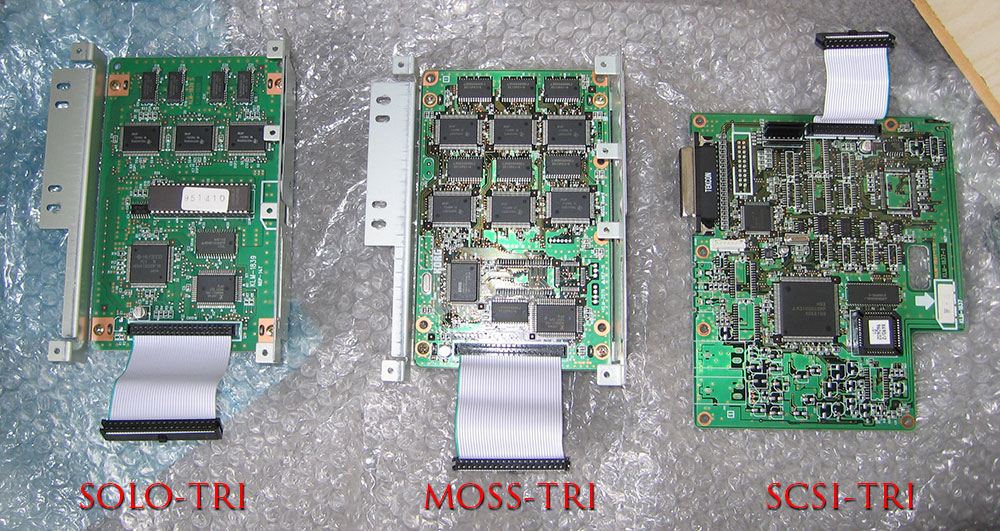I've read that the PBS-TRI consists of a board *and* two additional chips.
Does the same apply to the SOLO-TRI and MOSS-TRI, or do those expansions consist in a board only?
Thanks.
MOSS and SOLO boards: additional chips?
Moderators: Sharp, X-Trade, Pepperpotty, karmathanever
-
VegasGroove
- Posts: 14
- Joined: Sat Jan 21, 2017 5:19 am
- Location: Seven Hills, NV
- Timo
- Platinum Member
- Posts: 3106
- Joined: Thu Jan 24, 2002 8:53 am
- Location: Kaoss central, England
- Contact:
The PBS-TRI effectively contained two upgrades... The main expansion board itself added 8mb FlashROM for entirely new multisample waveform data. Then the two additional chips that were inserted into the Trinity's motherboard itself, separately, added two additional storage banks (C & D) for both Combi and Programs and doubled Solo/Moss bank storage from 64 to 128 patches (if Solo/Moss-TRI were installed).
You have to be aware of this when selling/buying the PBS-TRI, as people often forget or don't realise the two chips should be included - they may take out the FlashROM expansion board but forget they still have the chips in situ on the Trinity's mainboard elsewhere. This means the person who installs just the board will have the 8mb of FlashROM, but not the extra C & D bank storage.
Regards the Solo-TRI and Moss-TRI, they were boards only. If the Solo-TRI was added, it would enable and create a new bank of 'S' Programs, if a Moss-TRI were added it would create a new bank of 'M' Programs.
Even though Solo shares many things with Moss, both boards are actually incompatible with each other. You can't load Solo Programs into Moss (aside from the factory ones that Korg converted their end), or vice versa. Furthermore you can only have one of the two boards (Solo OR Moss) installed at any time, as they use the same slot. As mentioned on the other thread, Solo-TRI requires Trinity OS version 2.x in order for it to be detected, while the Moss-TRI board requires OS verson 3.x to be detected. If you try and use the opposite OS version to the one intended, neither of them will be detected.
You have to be aware of this when selling/buying the PBS-TRI, as people often forget or don't realise the two chips should be included - they may take out the FlashROM expansion board but forget they still have the chips in situ on the Trinity's mainboard elsewhere. This means the person who installs just the board will have the 8mb of FlashROM, but not the extra C & D bank storage.
Regards the Solo-TRI and Moss-TRI, they were boards only. If the Solo-TRI was added, it would enable and create a new bank of 'S' Programs, if a Moss-TRI were added it would create a new bank of 'M' Programs.
Even though Solo shares many things with Moss, both boards are actually incompatible with each other. You can't load Solo Programs into Moss (aside from the factory ones that Korg converted their end), or vice versa. Furthermore you can only have one of the two boards (Solo OR Moss) installed at any time, as they use the same slot. As mentioned on the other thread, Solo-TRI requires Trinity OS version 2.x in order for it to be detected, while the Moss-TRI board requires OS verson 3.x to be detected. If you try and use the opposite OS version to the one intended, neither of them will be detected.
<img src="http://www.infekted.org/timo/userbar-atmossphere.png" border="0" align="bottom" alt="Korg Moss Soundset"> [Free Moss Set For All Workstations With Moss Expansion]
<img src="http://www.infekted.org/timo/userbar-virus.png" align="bottom" border="0" alt="www.Infekted.org - Access Virus Community"> [Infekted.org - Original Access Virus Forum & Community]
Trinity V3 PBS | Radias KB | Virus TI Snow | Virus Indigo 1 | 505 Groovebox
<img src="http://www.infekted.org/timo/userbar-virus.png" align="bottom" border="0" alt="www.Infekted.org - Access Virus Community"> [Infekted.org - Original Access Virus Forum & Community]
Trinity V3 PBS | Radias KB | Virus TI Snow | Virus Indigo 1 | 505 Groovebox
- Timo
- Platinum Member
- Posts: 3106
- Joined: Thu Jan 24, 2002 8:53 am
- Location: Kaoss central, England
- Contact:
Pics added, for anyone interested.

Close up....

You can see the two C&D bank chips are not surface mounted (soldered) onto the Trinity's mainboard like all the others. They're user-accessible slots that you can insert the chips into. You have to be careful when you pop them in or out though as the chip's legs can be easily bent.
You can also see the round CR2032 battery toward the middle-left of the first couple of photos. I think I replaced it once, although can't remember the process. I believe it is soldered in.
The Moss/Solo piggy-backs onto the bottom of the SCSI-TRI/HDR-TRI, so you can only see the underside of the SCSI board on the photos.
A rare shot of the SOLO and MOSS boards side by side (for comparison only)...


Close up....

You can see the two C&D bank chips are not surface mounted (soldered) onto the Trinity's mainboard like all the others. They're user-accessible slots that you can insert the chips into. You have to be careful when you pop them in or out though as the chip's legs can be easily bent.
You can also see the round CR2032 battery toward the middle-left of the first couple of photos. I think I replaced it once, although can't remember the process. I believe it is soldered in.
The Moss/Solo piggy-backs onto the bottom of the SCSI-TRI/HDR-TRI, so you can only see the underside of the SCSI board on the photos.
A rare shot of the SOLO and MOSS boards side by side (for comparison only)...

<img src="http://www.infekted.org/timo/userbar-atmossphere.png" border="0" align="bottom" alt="Korg Moss Soundset"> [Free Moss Set For All Workstations With Moss Expansion]
<img src="http://www.infekted.org/timo/userbar-virus.png" align="bottom" border="0" alt="www.Infekted.org - Access Virus Community"> [Infekted.org - Original Access Virus Forum & Community]
Trinity V3 PBS | Radias KB | Virus TI Snow | Virus Indigo 1 | 505 Groovebox
<img src="http://www.infekted.org/timo/userbar-virus.png" align="bottom" border="0" alt="www.Infekted.org - Access Virus Community"> [Infekted.org - Original Access Virus Forum & Community]
Trinity V3 PBS | Radias KB | Virus TI Snow | Virus Indigo 1 | 505 Groovebox
Very interesting, thanks.
__
For me the ideal configuration would be a Trinity PRO V3 (including MOSS-TRI) + SCSI-TRI + PBS-TRI (a Korgish EX5, as it were ).
).
About PBS-TRI : is it usable without SCSI ? I mean, can you *add* samples to flash memory (e.g. from several floppy disks) without erasing the samples already loaded (*) ?
(*) on the EX5, when you load a file into flash mem, the existing samples are erased; you have to build your wave sets in RAM and to save them as a single file. Later you can load that file into flash.
__
For me the ideal configuration would be a Trinity PRO V3 (including MOSS-TRI) + SCSI-TRI + PBS-TRI (a Korgish EX5, as it were
About PBS-TRI : is it usable without SCSI ? I mean, can you *add* samples to flash memory (e.g. from several floppy disks) without erasing the samples already loaded (*) ?
(*) on the EX5, when you load a file into flash mem, the existing samples are erased; you have to build your wave sets in RAM and to save them as a single file. Later you can load that file into flash.
Last edited by EXer on Sun Jan 29, 2017 1:49 am, edited 1 time in total.
- Timo
- Platinum Member
- Posts: 3106
- Joined: Thu Jan 24, 2002 8:53 am
- Location: Kaoss central, England
- Contact:
The first thing to know is that the 8mb FlashROM is actually 4 x 2mb chips. Therefore, the maximum file size of any individual sample is 2mb. However if you use floppy disks, instead of SCSI/HDR, then the maximum file size of any individual sample becomes limited to the size of the floppy disk, in otherwords 1.4mb. Unfortunately you can't split a sample across more than one floppy disk.EXer wrote:About PBS-TRI : is it usable without SCSI ?
It's still very usable with floppies, though. All of Korg's own additional PCM sets are all floppy-based. Each set usually came on 7 floppy disks. It takes time to load them all, though, a minute or two.
If you wish to use your own samples, then learning to optimise them beforehand is good practice in order to fit as many samples on the available 8mb as you can, such as trimming samples, optimising loop regions, getting rid of release phases etc. using an audio editor.
As long as the samples can fit in the available chunks of remaining memory, yes, you can import them one-by-one, or import a whole bunch of them at once. The caveat is that once they're uploaded, you can't delete the samples individually, though. So if you wish to delete the samples and make space, you have to wipe the entire FlashROM. You can, however, save the samples back to floppy disk beforehand if you wish, although I'm not sure why you'd wish to do this anyway if you have the original samples themselves, but again you'd be limited to 1.4mb sample sizes. (Sometimes file-sizes of samples increase inside the Trinity when it imports and converts the samples for its own use, and therefore become larger if you attempt to save them back out again. For example if you upload a sample that was recorded at 44.1KHz, the Trinity will convert it to its native 48KHz once uploaded and therefore the file size of that sample will have increased.)I mean, can you *add* samples to flash memory (e.g. from several floppy disks) without erasing the samples already loaded (*) ?
The PBS and Moss are definitely the two best upgrades as they expand the Trinity hugely. The PBS is great for importing either your own samples or the available soundsets to boost the stock sounds, it turns the Trinity into a chameleon and brings new life to the synth's ROMpler-based sample engine, whereas the Moss brings an entirely new dimension by adding real analogue-emulated and physical modelling synthesis.
<img src="http://www.infekted.org/timo/userbar-atmossphere.png" border="0" align="bottom" alt="Korg Moss Soundset"> [Free Moss Set For All Workstations With Moss Expansion]
<img src="http://www.infekted.org/timo/userbar-virus.png" align="bottom" border="0" alt="www.Infekted.org - Access Virus Community"> [Infekted.org - Original Access Virus Forum & Community]
Trinity V3 PBS | Radias KB | Virus TI Snow | Virus Indigo 1 | 505 Groovebox
<img src="http://www.infekted.org/timo/userbar-virus.png" align="bottom" border="0" alt="www.Infekted.org - Access Virus Community"> [Infekted.org - Original Access Virus Forum & Community]
Trinity V3 PBS | Radias KB | Virus TI Snow | Virus Indigo 1 | 505 Groovebox